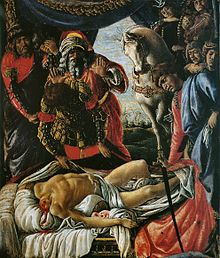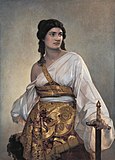Judith and Holofernes (subject)
Judith and Holofernes are characters from the book of Judith in the Old Testament . Its history has been presented in numerous variations in works of Western art, music and literature.
Judith as the embodiment of courage, determination, self-sacrificing patriotism, combined with female beauty - "she had a beautiful figure and a blooming appearance" ( Jdt 8,7 EU ) - has always inspired the imagination of the artists. Above all, the bloody spectacle of the beheading of Holofernes became a frequently varied subject from the late Middle Ages to the early 20th century.
Historical background
The book of Judith is an Old Testament short story in which events from the history of the Israelites , which stretch over a period of almost 400 years, are condensed into a teaching example. Centuries of disputes between the Israelites and the ancient empires of the Babylonians , Assyrians and Persians are summarized in a legend that is full of symbols. It should be made clear how the people of the Israelites must act in the highest danger from the threat of powerful external enemies and dwindling trust in God in order to experience God's help and to regain trust.
The book is not part of the Jewish canon , but the text is contained in the Septuagint and is therefore recognized by Catholic and Orthodox Christians as part of the Bible. Martin Luther included the book in the apocryphal writings of his translation of the Bible .
The book, written in Greek , was probably written in the late Hellenistic period .
Judith in the fine arts



Judith is depicted as a young and beautiful, richly dressed woman, with a sword in her hand, with the bloody head of Holofernes, more rarely with her breast bare or naked.
In medieval typology , Judith is the prefiguration of Mary as the conqueror of evil.
In pictorial representations of the Nine Good Heroines , she is one of the three representatives of Judaism alongside Jaël and Esther . Placed in front of the Palazzo Vecchio in Florence, it symbolizes, like Michelangelo's David , the victory of the republic over the rule of a tyrant.
Pictures and sculptures (selection)
- Azor Meister: Story of Judith (around 1430), illumination, 11 pictures, Royal Library The Hague ( → picture )
- Schedel's World Chronicle : Judith (1493), woodcut
- Andrea Mantegna : Judith and Holofernes (1495), The National Gallery of Art, Washington
- Donatello : Judith and Holofernes (around 1453–1457), bronze, Palazzo Vecchio, Florence
- Sandro Botticelli :
- Hans Burgkmaier : Judith (around 1502), woodcut in the series “Nine Heroes and Nine Heroines” . Kupferstichkabinett Basel
- Giorgione : Judith (around 1504), Hermitage St. Petersburg ( → picture )
- Michelangelo : Judith and Holofernes (1509), fresco, Sistine Chapel ( → picture )
- Hans Schäufelin : The victorious defense of the city of Bethulia against the general Holofernes (1515), fresco, Nördlinger town hall
- Titian :
-
Lucas Cranach the Elder :
- Judith with two companions (1525), Rau Collection, Remagen
- Judith with the head of Holofernes (around 1530), Kunsthistorisches Museum, Vienna
- Judith (1st third of the 16th century), Staatsgalerie Stuttgart ( → picture )
- Judith with the head of Holofernes (around 1530), Grunewald hunting lodge ( → picture )
- Konrad Meit : Judith with the head of Holofernes (around 1525), alabaster, Bavarian National Museum, Munich
- Jacopo Tintoretto : Judith and Holofernes (around 1550), Prado in Madrid ( → picture )
- Cristofano Allori :
-
Paolo Veronese
- Judith with the head of Holofernes (around 1580), Kunsthistorisches Museum Vienna
- Judith and Holofernes (1582), Palazzo Rossi, Genoa
- Palma il Giovane : Judith and Holofernes (1590–1600), Louvre in Paris; Weser Renaissance Museum Brake Castle ( → picture )
- Fede Galizia : Judith with the head of Holofernes (1596–1601), Galleria Borghese in Rome, Ringling Museum of Art in Sarasota and private collection in Milan ( → picture )
- Michelangelo Caravaggio : Judith and Holofernes (1598–1599), Galleria Nazionale di Arte Antica, Rome ( → picture )
-
Artemisia Gentileschi :
- Judith and Holofernes (1612/1621), Uffizi Gallery, Florence ( → picture )
- Judith with the head of Holofernes (1612/13), Palazzo Pitti in Florence ( → picture )
- Judith kills Holofernes (after 1612), Museo di Capodimonte , Naples
- Carlo Saraceni : Judith with the head of Holofernes (1615/1620) ( → picture )
- Peter Paul Rubens : Judith with the head of Holofernes (around 1616), Herzog Anton Ulrich-Museum , Braunschweig ( → picture )
-
Simon Vouet :
- Judith with the head of Holofernes (around 1617/18), Bayerische Staatsgemäldesammlungen, Munich
- Judith with the head of Holofernes , Kunsthistorisches Museum, Vienna
- Johann Liss : Judith in the tent of Holofernes (1622), Kunsthistorisches Museum Vienna ( → picture )
- Guido Reni : Judith with the head of Holofernes (before 1623), private collection
-
Rembrandt
- Judith at the Banquet of Holofernes (1634), Prado in Madrid
- Judith beheads Holofernes (around 1653), pen drawing, Museo Capo die Monte, Naples
- Elisabetta Sirani : Judith with the head of Holofernes (1658), Burgleigh House ( → picture )
- Francesco Maffei : Judith with the head of Holofernes (1650–1660), Pinacoteca Comunale, Faenza
- Johann Bockhorst : Judith and Holofernes (around 1660), Münster City Museum
- Johann Spillenberger : Judith with the head of Holofernes , private property, Regensburg, 99 × 75 cm, oil on canvas
- Philip van Dijk : Judith with the head of Holofernes (1726), Mauritshuis Den Haag ( → picture )
- Francesco Solimena : The Triumph of Judith (around 1730) Kunsthistorisches Museum, Vienna ( → picture )
- Francisco Goya : Judith and Holofernes (1819/23), Prado in Madrid ( → picture )
- August Riedel : Judith (1840), Neue Pinakothek, Munich
- Hugo von Habermann : Judith in the tent of Holofernes (1873)
-
Gustav Klimt :
- Judith I (1901), Belvedere , Vienna
- Judith II (1909), Galleria Nazionale d'Arte Moderna , Rome
- Lovis Corinth : The Book of Judith. (1910), color lithographs, 22 sheets, Von der Heydt-Museum, Wuppertal ( → picture )
- Koloman Moser : Judith and Holofernes (1916), Leopold Museum, Vienna ( → picture )
- Franz von Stuck : Judith and Holofernes (1927), Otto Heilmann Collection, Munich
- Arturo Martini : Judith and Holofernes (1932/33), stone sculpture, Kröller-Müller Museum , Otterlo ( → picture )
- Max Ernst : Le lit d'Holopherne (1961), Max Ernst Museum Brühl. ( → picture )
Judith in literature (selection)
- Hans Sachs : Judith, the messig , ballad, 1531, ( digitized )
- Joachim Greff : Tragedia of the book Judith in Deudsche Reim. Wittenberg 1536 ( digital copy from HAAB Weimar )
- Martin Luther : Preface to the Book of Judith , 1534, in: Manfred Vorkamm (Hrsg.): Luther’s Preface to the Bible , Frankfurt 1883 ( zeno.org )
- Sixtus Birck : Judith , 1539 ( zeno.org )
- Georg Wickram : The drunken Holofernes , 1539
- Samuel Hebel: A game from the occupation of the city of Bethulia , 1566
- Cornelius Schonaeus : Juditha , 1592
- Martin Behm : Tragicomedia. A beautiful German game by Holoferne and Judith , Wittenberg 1618
- Martin Opitz : Judith , 1635
- Claude Boyer: Judith. Tragédie en 5 actes , Paris 1718 ( digital copy, PDF )
- Paul Duhamel : Béthule delivrée. Tragedy , Paris 1772
- Anonymous. Judith and Holofernes. A drama in five acts , Zerbst 1818
- Friedrich Hebbel : Judith , 1840
- Johann Nepomuk Nestroy : Judith and Holofernes , 1849
- Jean Giraudoux : Judith , Paris 1931
- Howard Barker : Judith: A Parting from the Body , 1992
- Meir Shalev : Judith's Love , 1994
- Walter Laufenberg: The sinner. Vienna 1683 , Munich 2018
Operas and oratorios (selection)
- Alessandro Scarlatti : La Giuditta. Oratorio en dos partes. (1695)
- Georg Caspar Schürmann : L'Amor insanguinato or Holofernes . Libretto by Joachim Beccau (1716).
- Antonio Vivaldi : Juditha triumphans devicta Holofernis barbarie. Oratory (1716)
- Francisco de Almeida : La Giuditta. Oratory (1726)
- Pietro Metastasio : La Betulia liberata . Oratorio libretto set to music by around 50 composers (1734).
- Wolfgang Amadeus Mozart : La Betulia liberata . Oratorio based on the libretto by Metastasio. K. 118 (74c) (1771)
- Alexander Nikolajewitsch Serow : Judith. Opera (1863-1865)
- Emil Nikolaus von Reznicek : Holofernes. Opera (1923)
- Arthur Honegger : Judith / Cantique De Paques. (1925)
- Eugène Aynsley Goossens : Judith. Opera in one act. Libretto by Arnold Bennett (1927)
- Siegfried Matthus : Judith . Opera based on the drama of the same name by Friedrich Hebbel and texts from books of the Old Testament. (1979)
Text dubbing
- Spem in alium , motet by Thomas Tallis (around 1570)
pop music
- Judith Holofernes is the stage name of Judith Holfelder-Roy, lead singer of the pop-rock group Wir sind Helden .
Movie
- Judith of Bethulia , directed by David Wark Griffith , (1914)
- Giuditta e Oloferne , directed by Baldassarre Negroni , silent film (1929)
- Judith, The Sword of Vengeance , directed by Fernando Cerchio (1958)
literature
- Otto Baltzer: Judith in German literature. History of material and motifs in German literature . 7. Berlin 1930.
- Barbara Schmitz: Trickster, scribe or femme fatale? The Judit figure between biblical narrative and art-historical reception. In: Biblical Forum 2004 ( excerpt as PDF )
- Bettina Uppenkamp: Judith and Holofernes in Italian Baroque painting. Berlin 2004. ISBN 3-496-01304-4
- Adelheid Straten: The Judith theme in Germany in the 16th century. Studies in Iconography - Materials and Contributions . Diss. LMU Munich 1982. Minerva Fachserie Kunst 1983, ISBN 978-3-597-10486-3
- The gallery of strong women. The heroine in 17th century French and Italian art . Arranged by Bettin Baumgärtel and Silvia Neyserts. Exhibition in Darmstadt and Düsseldorf, 1995/1996.
- Matthias Morgenstern : Theater and Zionist Myth. A study of contemporary Hebrew drama with a special focus on the work of Joshua Sobol . Tübingen 2002, pp. 102–115 (on the Judith piece "Judith among the Lepers" by Mosche Schamir )
Web links
- Barbara Schmitz: Judit. In: Michaela Bauks, Klaus Koenen, Stefan Alkier (eds.): The scientific Bibellexikon on the Internet (WiBiLex), Stuttgart 2006 ff., Accessed on January 27, 2013. With a detailed bibliography on the history of reception.
- Bible Paintings, Judith and Holofernes
Individual evidence
- ↑ Barbara Schmitz: Judit. In: Michaela Bauks, Klaus Koenen, Stefan Alkier (Eds.): The Scientific Bibellexicon on the Internet (WiBiLex), Stuttgart 2006 ff., Accessed on January 27, 2013.
- ↑ Judith with the head of Holofernes. In: Sandrart.net. Retrieved December 20, 2014 .







